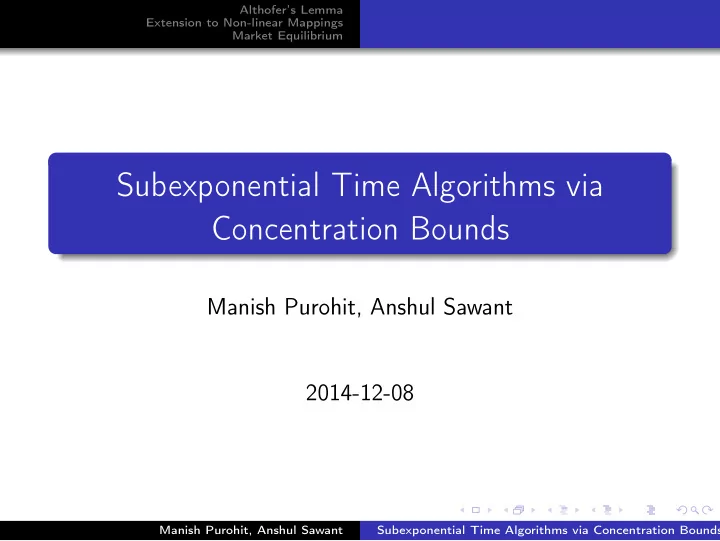

Althofer’s Lemma Extension to Non-linear Mappings Market Equilibrium Subexponential Time Algorithms via Concentration Bounds Manish Purohit, Anshul Sawant 2014-12-08 Manish Purohit, Anshul Sawant Subexponential Time Algorithms via Concentration Bounds
Althofer’s Lemma Extension to Non-linear Mappings Market Equilibrium Outline Althofer’s Lemma 1 Extension to Non-linear Mappings 2 Market Equilibrium 3 Manish Purohit, Anshul Sawant Subexponential Time Algorithms via Concentration Bounds
Althofer’s Lemma Extension to Non-linear Mappings Market Equilibrium Motivation Computation of equilibria in 2-player games is a hard problem. However, if strategies are sparse and uniform then the search space is sub-exponential. Althofer Lemma guarantees existence of such a grid in strategy space of players. We will give a novel application of this sparsification technique in the second half. Manish Purohit, Anshul Sawant Subexponential Time Algorithms via Concentration Bounds
Althofer’s Lemma Extension to Non-linear Mappings Market Equilibrium Sparse Solutions to Linear Systems: Althofer’s Lemma Let p = ( p 1 , . . . , p n ) be any probability vector, i.e., � n i = 1 p i = 1 , p i ≥ 0. Let A be any m × n matrix with all entries between 0 and 1. Let A i be the i th row of A . Then the linear transform Ap can be approximated by Aq , where probability vector q is: approximate representation of p | A i · ( p − q ) | ≤ ǫ, i ∈ { 1 , . . . , n } . sparse at most k = log 2 m entries are non-zero. 2 ǫ 2 uniform all entries are of form q i = k i k , k i is integral Manish Purohit, Anshul Sawant Subexponential Time Algorithms via Concentration Bounds
Althofer’s Lemma Extension to Non-linear Mappings Market Equilibrium Proof Outline Construct a sparse representation of p by sampling. Use Hoeffding bound and union bound to prove that with non-zero probability, the constructed representation is an approximate representation of p . This proved existence of a sparse representation. Manish Purohit, Anshul Sawant Subexponential Time Algorithms via Concentration Bounds
Althofer’s Lemma Extension to Non-linear Mappings Market Equilibrium Proof Outline : Construction of Sparse Representation Let p = ( p 1 , . . . , p n ) be a given probability vector. Sample k times with replacement from set { 1 , . . . , n } with probability of sampling i given by p i . Let S be the multiset representing the result of the above sampling. Let n i be the number of times i occurs in S . Then q i = n i k . Manish Purohit, Anshul Sawant Subexponential Time Algorithms via Concentration Bounds
Althofer’s Lemma Extension to Non-linear Mappings Market Equilibrium Proof Outline : Properties of Sparse Representation Probability vector q = ( q 1 , . . . , q n ) : is sparse at most k non-zero entries. is uniform all entries are multiples of 1 k . preserves dot products E ( a · q ) = a · p . Manish Purohit, Anshul Sawant Subexponential Time Algorithms via Concentration Bounds
Althofer’s Lemma Extension to Non-linear Mappings Market Equilibrium Proof Outline To prove existence of sparse q , we need to choose appropriate k . Dot products are preserved in expectation, therefore, the linear transform Ap is preserved in expectation. We use Hoeffding bound and union bound to choose appropriate value of k . Manish Purohit, Anshul Sawant Subexponential Time Algorithms via Concentration Bounds
Recommend
More recommend